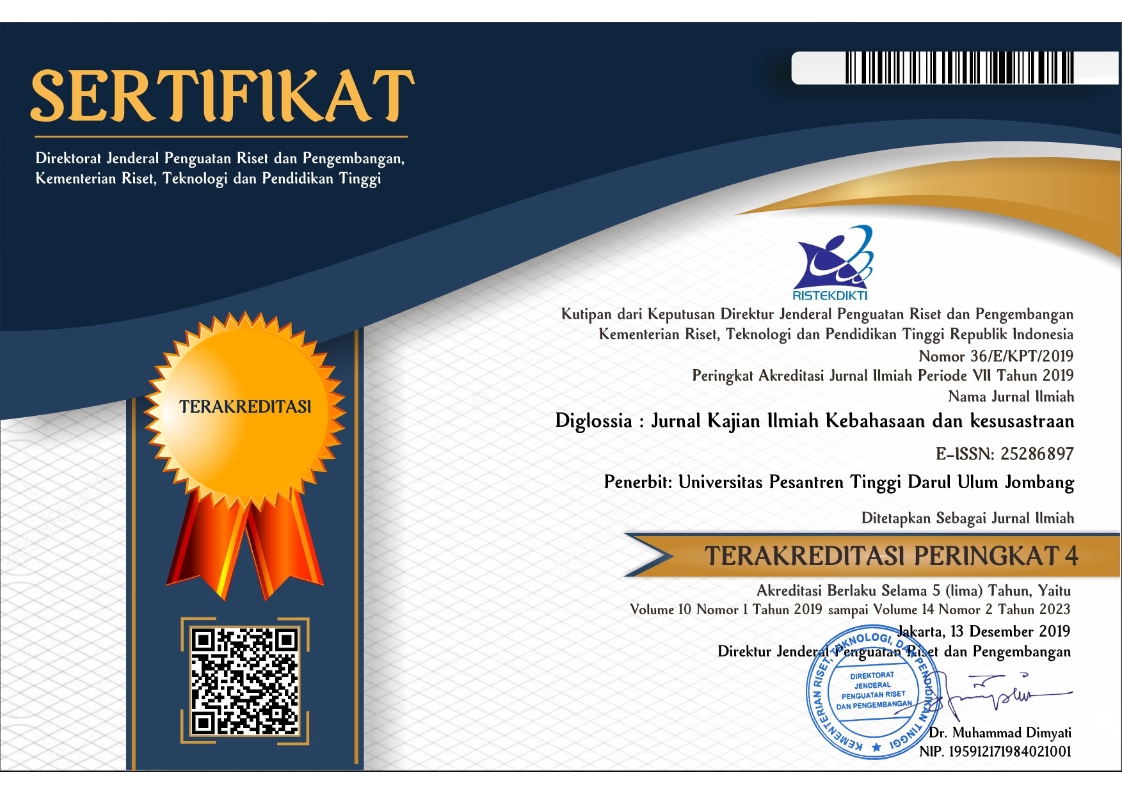Common Mistakes Faced by Student Indonesian to English Simultaneous Interpreting
DOI:
https://doi.org/10.26594/diglossia.v13i2.2439Keywords:
errors; , Indonesia to English simultaneous interpreting, problem in simultaneous interpretingAbstract
Abstract
A lot of people seem to be unaware of the difference between interpreter and translator. Different practices lead to different skills. This study aims to find common mistakes that are often made by students in interpreting. The data were obtained from five students who had undergo interpreting classes for one year from 2020 January until December. These five Master degree students attended the interpreting class 32 times with a total study time of 90 hours. The data were taken in an online class, after that this study analyze transcripts, validate errors, and interview students. The study found that the most common mistakes were hestitations and omissions. These mistakes are caused by several factors, namely nervous and time pressure, lack of background knowledge and lack of language proficiency, as well as poor network connection and environmental noise
Keywords: errors; Indonesia to English simultaneous interpreting, problem in simultaneous interpreting
Abstrak
Banyak orang yang belum mengetahui perbedaan penerjemah dan penjurubahasa, padahal pekerjaan yang berbeda memerlukan kemampuan yang berbeda. Penelitian ini bertujuan untuk menemukan kesalahan umum yang sering dilakukan mahasiswa yang mempelajari penjurubahasaan. Data diperoleh dari lima mahasiswa yang telah mengikuti kelas penjurubahasaan selama satu tahun dari Januari sampai Desember 2020. Lima mahasiswa ini menghadiri kelas jurubahasa sebanyak 32 kali dengan total waktu belajar 90 jam. Penelitian ini menerapkan metode kualitatif dengan menganalisis transkrip, melihat validasi kesalahan, dan mewawancara murid. Studi ini menemukan bahwa kesalahan yang paling umum dilakukan adalah keraguan dan penghapusan. Kesalahan ini disebabkan beberapa faktor yaitu keraguan dan tekanan waktu, kurangnya pengetahuan umum dan kemampuan berbahaasa asing, serta jaringan internet yang buruk dan lingkungan yang bising.
Kata Kunci: kesalahan, interpreter simultan Bahasa Inggris- Bahasa Indonesia, permasalahan dalam interpreter simultan
References
Angelelli, C.V. (2004). Medical Interpreting and Cross-cultural Communication. New York: Cambridge University Press.
Barik, H. (1997). A description of various types of omission, additions, and errors of translation encountered in simultaneous interpretation. Meta Translations’ Journal, 199-210.
Choi, J.-W. (2003). The Interpretive Theory of Translation and Its Current Applications. Japan Association for Interpretation Studies, 1-15.
Hale, S.B. (2004). The Discourse of Court Interpreting. Amsterdam/Philadelphia: John Benjamins Publishing Company.
Heinz, M. (2013). Impromptu speaking and interpretation studies: A preliminary study. Journal of International Education Research (JIER), 9(4), 387-396.
Li, S. (2014). A case study of interpretation learning strategies employed by successful interpretation learners. Theory and Practice in Language Studies, 4(6), 1303-1311.
Obler, L. K. (2012). Conference Interpreting as Extreme Language Use. International Journal of Bilingualism 16 (2): 177–182. doi:10.1177/1367006911403199
Pöchhacker, F. (2004). Introducing Interpreting Studies. New York: Routledge.
Roy, C.B., Brunson, J.L., & Stone, C.A. (2018). The Academic Foundations of Interpreting Studies. Washington DC: Gallaudet University Press.
Srka Timarova and Heidi Salaets. (2014). Learning styles, motivation and cognitive flexibility in interpreter training: Self-selection and aptitude. Franz Po?chhacker and Minhua Liu (Eds.). Aptitude for Interpreting. John Benjamins Publishing.
Schäffner, C. (2004). Translation Research and Interpreting Research. England: Cromwell Press.
Wang, B., & Zou, B. (2018). Exploring language specificity as a variable in Chinese-English interpreting. A corpus-based investigation. In Making Way in Corpus-based Interpreting Studies, 65-82. Springer, Singapore.
Yamada, H. (2019). A Direct Application of Simultaneous Interpreting Training without Prior Consecutive Interpreting Work in a University Course. Theory and Practice in Language Studies, 9(4), 353-363.
Downloads
Published
Issue
Section
License
Copyright (c) 2022 Diglossia: Jurnal Kajian Ilmiah Kebahasaan dan Kesusastraan

This work is licensed under a Creative Commons Attribution 4.0 International License.
- Authors who submit a manuscript to this journal and accepted for publication, copyright of the article shall be assigned to the authors of the article.
- Copyright encompasses exclusive rights to reproduce and deliver the article in all forms and media, including reprints, photographs, and any other similar reproductions, as well as translations. The reproduction of any part of this journal, its storage and transmission of databases by any forms or media, such as electronic, mechanical copies, photocopies, and recordings will be allowed by Diglossia
- Editorial Board of Diglossia tries to make every effort to ensure that no wrong or misleading data, opinions or statements be published in the journal. The contents of the articles published to Diglossia are sole and exclusive responsibility of their respective authors.
- The copyright form should be filled with respect to article and be signed originally and sent scanned document file (softcopy) and the article to our email, jurnal.diglossia@fbs.unipdu.ac.id or sent it to the Editorial Office in the form of original hard copy and the article in softcopy form on Flash Disc or Compact Disc, to;Diglossia: Jurnal Kajian Ilmiah Kebahasaan dan Kesusastraan
Prodi Sastra Inggris Fakultas Bisnis dan Bahasa
Universitas Pesantren Tinggi Darul Ulum
Kompleks Pondok Pesantren Darul Ulum
Rejoso Peterongan Jombang Jawa Timur 61481






